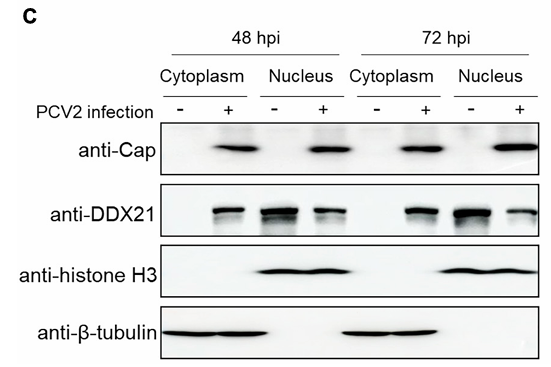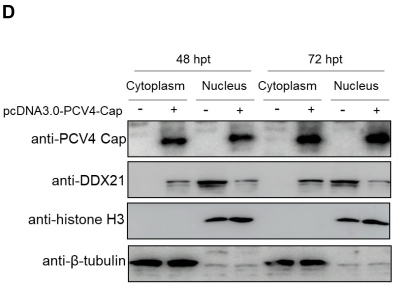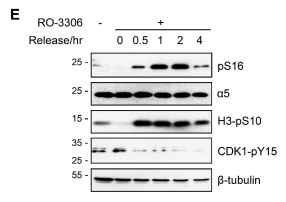Beta III Tubulin Rabbit Polyclonal Antibody
Specification
Catalog# 0807-2
Beta III Tubulin Rabbit Polyclonal Antibody
-
WB
-
IF-Cell
-
FC
-
Human
-
Mouse
-
Rat
Overview
Product Name
Beta III Tubulin Rabbit Polyclonal Antibody
Antibody Type
Rabbit Polyclonal Antibody
Immunogen
Synthetic peptide within Human Beta III Tubulin aa 401-450 / 450.
Species Reactivity
Human, Mouse, Rat
Validated Applications
WB, IF-Cell, FC
Molecular Weight
Predicted band size: 50 kDa
Positive Control
SH-SY5Y cell lysate, Human brain tissue lysate, Mouse brain tissue lysate, Rat brain tissue lysate, SH-SY5Y, PC-12.
Conjugation
unconjugated
RRID
Product Features
Form
Liquid
Storage Instructions
Shipped at 4℃. Store at +4℃ short term (1-2 weeks). It is recommended to aliquot into single-use upon delivery. Store at -20℃ long term.
Storage Buffer
1*PBS (pH7.4), 0.2% BSA, 40% Glycerol. Preservative: 0.05% Sodium Azide.
Isotype
IgG
Purification Method
Immunogen affinity purified.
Application Dilution
-
WB
-
1:2,000
-
IF-Cell
-
1:500
-
FC
-
1:1,000
Applications in Publications
Species in Publications
| Pig | See 4 publications below |
| Human | See 2 publications below |
| Mouse | See 1 publications below |
Target
Function
Tubulin is one of several members of a small family of globular proteins. The most common members of the tubulin family are α-tubulin and β-tubulin. The beta-tubulin (relative molecular weight about 50 kDa) is counterpart of alpha-tubulin in tubulin heterodimer, it is coded by multiple tubulin genes and it is also posttranslationally modified. Heterogeneity of subunit is concentrated in C-terminal structural domain. Beta-Tubulin may have bound GTP or GDP. Under certain conditions β-tubulin can hydrolyze its bound GTP to GDP plus Pi, release the Pi, and exchange the GDP for GTP.
Background References
1. Westermann, S. and Weber, K. (2003) Nat. Rev. Mol. Cell Biol. 4, 938 -947.
2. Ranganathan S., Dexter D.W., Benetatos C.A., Hudes G.R.; "Cloning and sequencing of human betaIII-tubulin cDNA: induction of betaIII isotype in human prostate carcinoma cells by acute exposure to antimicrotubule agents."; Biochim. Biophys. Acta 1395:237-245(1998).
3. The MGC Project Team; "The status, quality, and expansion of the NIH full-length cDNA project: the Mammalian Gene Collection (MGC)."; Genome Res. 14:2121-2127(2004).
Sequence Similarity
Belongs to the tubulin family.
Tissue Specificity
Expression is primarily restricted to central and peripheral nervous system. Greatly increased expression in most cancerous tissues.
Post-translational Modification
Some glutamate residues at the C-terminus are polyglutamylated, resulting in polyglutamate chains on the gamma-carboxyl group. Polyglutamylation plays a key role in microtubule severing by spastin (SPAST). SPAST preferentially recognizes and acts on microtubules decorated with short polyglutamate tails: severing activity by SPAST increases as the number of glutamates per tubulin rises from one to eight, but decreases beyond this glutamylation threshold.; Some glutamate residues at the C-terminus are monoglycylated but not polyglycylated due to the absence of functional TTLL10 in human. Monoglycylation is mainly limited to tubulin incorporated into axonemes (cilia and flagella). Both polyglutamylation and monoglycylation can coexist on the same protein on adjacent residues, and lowering glycylation levels increases polyglutamylation, and reciprocally. The precise function of monoglycylation is still unclear (Probable).; Phosphorylated on Ser-172 by CDK1 during the cell cycle, from metaphase to telophase, but not in interphase. This phosphorylation inhibits tubulin incorporation into microtubules.
Subcellular Location
Cytoplasm, cytoskeleton, Cell projection, growth cone, lamellipodium, filopodium.
Synonyms
beta 3 tubulin antibody
beta 4 antibody
beta-4 antibody
CDCBM antibody
CDCBM1 antibody
CFEOM3 antibody
CFEOM3A antibody
FEOM3 antibody
M(beta)3 antibody
M(beta)6 antibody
Expandbeta 3 tubulin antibody
beta 4 antibody
beta-4 antibody
CDCBM antibody
CDCBM1 antibody
CFEOM3 antibody
CFEOM3A antibody
FEOM3 antibody
M(beta)3 antibody
M(beta)6 antibody
MC1R antibody
Neuron specific beta III Tubulin antibody
Neuron-specific class III beta-tubulin antibody
QccE-11995 antibody
QccE-15186 antibody
TBB3_HUMAN antibody
Tubb 3 antibody
TUBB3 antibody
TUBB4 antibody
Tubulin beta 3 antibody
Tubulin beta 3 chain antibody
Tubulin beta 4 antibody
Tubulin beta III antibody
Tubulin beta-3 chain antibody
Tubulin beta-4 chain antibody
Tubulin beta-III antibody
tuj 1 antibody
tuj1 antibody
CollapseImages
-

Western blot analysis of Beta III Tubulin on different lysates with Rabbit anti-Beta III Tubulin antibody (0807-2) at 1/2,000 dilution.
Lane 1: SH-SY5Y cell lysate (20 µg/Lane)
Lane 2: Human brain tissue lysate (40 µg/Lane)
Lane 3: Mouse brain tissue lysate (40 µg/Lane)
Lane 4: Rat brain tissue lysate (40 µg/Lane)
Predicted band size: 50 kDa
Observed band size: 50 kDa
Exposure time: 2 seconds; ECL: K1801;
4-20% SDS-PAGE gel.
Proteins were transferred to a PVDF membrane and blocked with 5% NFDM/TBST for 1 hour at room temperature. The primary antibody (0807-2) at 1/2,000 dilution was used in 5% NFDM/TBST at 4℃ overnight. Goat Anti-Rabbit IgG - HRP Secondary Antibody (HA1001) at 1/50,000 dilution was used for 1 hour at room temperature. -

Immunocytochemistry analysis of SH-SY5Y cells labeling Beta III Tubulin with Rabbit anti-Beta III Tubulin antibody (0807-2) at 1/500 dilution.
Cells were fixed in 4% paraformaldehyde for 15 minutes at room temperature, permeabilized with 0.1% Triton X-100 in PBS for 15 minutes at room temperature, then blocked with 1% BSA in 10% negative goat serum for 1 hour at room temperature. Cells were then incubated with Rabbit anti-Beta III Tubulin antibody (0807-2) at 1/500 dilution in 1% BSA in PBST overnight at 4 ℃. Goat Anti-Rabbit IgG H&L (iFluor™ 488, HA1121) was used as the secondary antibody at 1/1,000 dilution. PBS instead of the primary antibody was used as the secondary antibody only control. Nuclear DNA was labelled in blue with DAPI.
Beta tubulin (HA601187, red) was stained at 1/100 dilution overnight at +4℃. Goat Anti-Mouse IgG H&L (iFluor™ 594, HA1126) was used as the secondary antibody at 1/1,000 dilution. -

Immunocytochemistry analysis of PC-12 cells labeling Beta III Tubulin with Rabbit anti-Beta III Tubulin antibody (0807-2) at 1/500 dilution.
Cells were fixed in 4% paraformaldehyde for 15 minutes at room temperature, permeabilized with 0.1% Triton X-100 in PBS for 15 minutes at room temperature, then blocked with 1% BSA in 10% negative goat serum for 1 hour at room temperature. Cells were then incubated with Rabbit anti-Beta III Tubulin antibody (0807-2) at 1/500 dilution in 1% BSA in PBST overnight at 4 ℃. Goat Anti-Rabbit IgG H&L (iFluor™ 488, HA1121) was used as the secondary antibody at 1/1,000 dilution. PBS instead of the primary antibody was used as the secondary antibody only control. Nuclear DNA was labelled in blue with DAPI.
Beta tubulin (HA601187, red) was stained at 1/100 dilution overnight at +4℃. Goat Anti-Mouse IgG H&L (iFluor™ 594, HA1126) was used as the secondary antibody at 1/1,000 dilution. -

Flow cytometric analysis of SH-SY5Y cells labeling Beta III Tubulin.
Cells were fixed and permeabilized. Then stained with the primary antibody (0807-2, 1/1,000) (red) compared with Rabbit IgG Isotype Control (green). After incubation of the primary antibody at +4℃ for an hour, the cells were stained with a iFluor™ 488 conjugate-Goat anti-Rabbit IgG Secondary antibody (HA1121) at 1/1,000 dilution for 30 minutes at +4℃. Unlabelled sample was used as a control (cells without incubation with primary antibody; black).
Please note: All products are "FOR RESEARCH USE ONLY AND ARE NOT INTENDED FOR DIAGNOSTIC OR THERAPEUTIC USE"
Citation
-
DEAD-box RNA helicase 21 interacts with porcine circovirus type 2 Cap protein and facilitates viral replication
Author: Zhou Jianwei, Cui Yongqiu, Hou Lei, Liu Jue
PMID: 38380105

Journal: Frontiers In Microbiology
Application: WB
Reactivity: Pig
Publish date: 2024 Feb
-
Citation
-
A previously unidentified circRNA inhibits virus replication by regulating the miR-24-3p/KEAP1 axis
Author: Haimin Li, Liuyang Du, Juan Li, Yanming Huang, Chenhe Lu, Tingjuan Deng, Yan Yan, Yulan Jin, Wei Wu, Jinyan Gu, Jiyong Zhou
PMID: 39689152

Journal: PLoS Pathogens
Application: WB
Reactivity: Pig
Publish date: 2024 Dec
-
Citation
-
Intestinal epithelial cell autophagy deficiency suppresses inflammation-associated colon tumorigenesis
Author: Liu, H., Lou, J., Liu, Y., Liu, Z., Xie, J., Sun, J., Pan, H., & Han, W.
PMID: 35317201

Journal: Molecular Therapy-Nucleic Acids
Application: WB
Reactivity: Mouse
Publish date: 2022 Feb
-
Citation
-
Contribution of DEAD-Box RNA Helicase 21 to the Nucleolar Localization of Porcine Circovirus Type 4 Capsid Protein
Author: Zhou, J., Wang, Y., Qiu, Y., Wang, Y., Yang, X., Liu, C., Shi, Y., Feng, X., Hou, L., & Liu, J.
PMID: 35283818

Journal: Contribution Of Dead-Box Rna Helicase 21 To The Nucleolar Localization Of Porcine Circovirus Type 4 Capsid Protein
Application: WB
Reactivity: Pig
Publish date: 2022 Feb
-
Citation
-
Conserved Mitotic Phosphorylation of a Proteasome Subunit Regulates Cell Proliferation
Author: Duan, J., Li, W., Shu, X., Yang, B., He, X., & Guo, X.
PMID: 34831298

Journal: Cells
Application: WB
Reactivity: Human
Publish date: 2021 Nov
-
Citation
-
Nucleolar protein NPM1 is essential for circovirus replication by binding to viral capsid
Author: Jinyan Gu; Jiyong Zhou
PMID: 33073687
Journal: Virulence
Application: WB,Co-IP
Reactivity: Human
Publish date: 2020 Dec
-
Citation
-
Caspase-Dependent Apoptosis Induction via Viral Protein ORF4 of Porcine Circovirus 2 Binding to Mitochondrial Adenine Nucleotide Translocase 3
Author: Jiyong Zhou
PMID: 29491154
Journal: Journal Of Virology
Application: WB
Reactivity: Pig
Publish date: 2018 Apr
-
Citation
Alternative Products
Beta III Tubulin Recombinant Rabbit Monoclonal Antibody [SP06-00]
Application: WB,IHC-P,IP,FC,IHC-Fr,IF-Cell
Reactivity: Human,Mouse,Rat
Conjugate: unconjugated
Products with the same target and pathway
Beta III Tubulin Rabbit Polyclonal Antibody
Application: WB,IF-Cell,IHC-P,FC,IF-Tissue
Reactivity: Human,Mouse,Rat
Conjugate: unconjugated
iFluor™ 594 Conjugated Beta III Tubulin Mouse Monoclonal Antibody [A8-D10]
Application: IF,ICC,FC
Reactivity: Human,Rat
Conjugate: iFluor™ 594
Beta III Tubulin Recombinant Rabbit Monoclonal Antibody [SP06-00]
Application: WB,IHC-P,IP,FC,IHC-Fr,IF-Cell
Reactivity: Human,Mouse,Rat
Conjugate: unconjugated
iFluor™ 488 Conjugated Beta III Tubulin Mouse Monoclonal Antibody [A8-D10]
Application: IF-Cell,FC,IF-Tissue
Reactivity: Human,Mouse,Rat
Conjugate: iFluor™ 488
Beta III Tubulin Rabbit Polyclonal Antibody
Application: WB,IF-Cell,IHC-P,FC
Reactivity: Human,Mouse,Rat
Conjugate: unconjugated
Beta III Tubulin Mouse Monoclonal Antibody [A8-D10]
Application: WB,IF-Cell,IHC-P,FC,IF-Tissue
Reactivity: Human,Mouse,Rat
Conjugate: unconjugated







